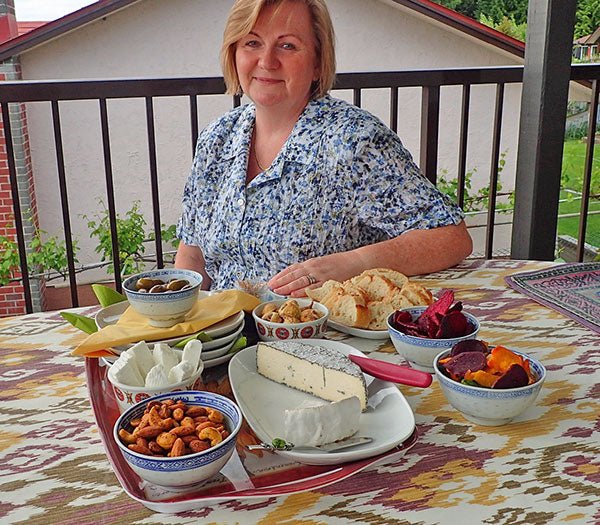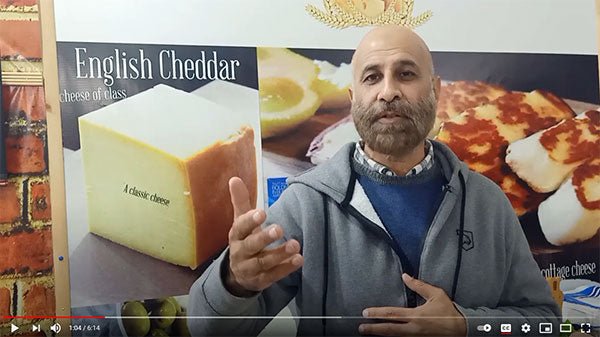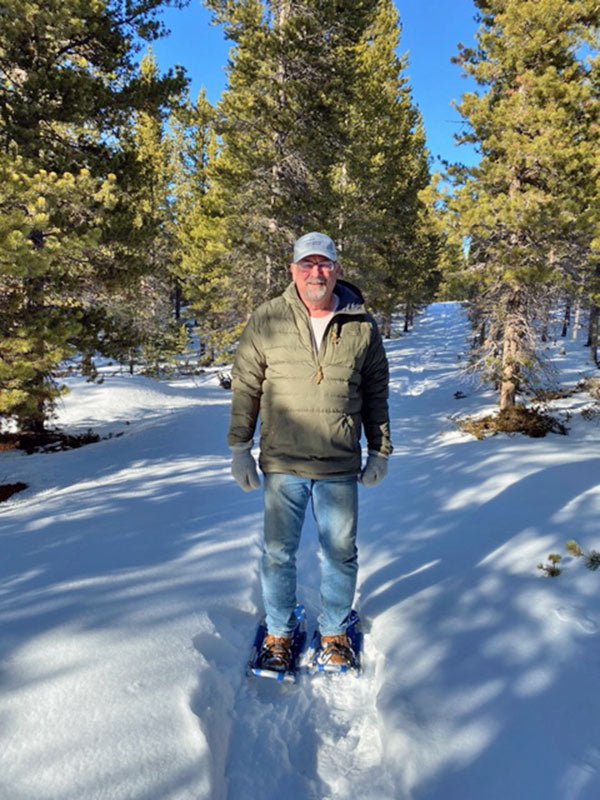
With a small sample of summer treats on the deck of our house – Goat Feta sticks, Brie and Coastal Blue. We spend a lot of time on our deck in the summer, eating cheese and drinking wine with friends and family.
I was born in England, my family moved to Canada in 1965, when I was just 3 years old. My husband, Steven, and I moved from Vancouver BC to Powell River in 2010 in order for me to start the CT Scan program at the local hospital. Steven is a New Englander himself, born in Maine but moved to Canada, also in 1965, with his family. They lived in Powell River for 3 years in his teens.
Located on the mainland and though not an island by definition, Powell River is a community on the Northern Sunshine Coast of British Colombia, Canada, isolated by ocean and mountains and is only accessible from the rest of B.C. by water (BC Ferries).

Dolphins breaching with Powell River in the background. (My husband, Steven, is the photographer in the family and took all the pictures in this article.)
Once you have arrived on the Northern Sunshine Coast by ferry, there is approximately 56kms (35 miles) of road along the coastline that passes through Powell River and ultimately leads you to Lund, BC. – a small community that many former US residents escaped to during the Vietnam draft to live a more freestyle life. So, we have a very eclectic range of personalities in our community.
There are approximately 24,000 people living on this 56km section of the coast, 14,000 in the city proper. So, once you are on the coast, in addition to ocean activities, you have access to 32 lakes, 100s of kms of groomed off track cycling trails, back country skiing (undeveloped), and the wonderful 180km Sunshine Coast Trail, Canada’s longest hut-to-hut hiking trail, a remarkable back country experience near Powell River.
I took my first cheese making class at our local community centre with Paula Maddison of Madd Acres on Gabriola Island in early 2016 and I was off and running with a new passion. Not many hobbies are so acutely appreciated and encouraged by your family and friends -> a consumable delicacy.
How many people have far too much ‘stuff’ from their hobbies cluttering up their homes? No one has ever complained or said “No, thank you” when I said, “I’m bringing cheese!”
Over a few workshops with Paula, I learned how to make Farmhouse Cheddar, Havarti and Brie. Many of my first cultures and supplies came from New England Cheesemaking Supply via Paula.

A draining day of soft cheese making: Goat Feta draining, Chevre draining, 2 Brie at the start of their flipping
After borrowing Artisan Cheese Making at Home by Mary Karlin, from the local library, and later purchasing my own copy, as well as buying 200 Easy Homemade Cheese Recipes by Debra Amrein-Boyes, I was well and truly hooked on the fascinating science of cheese making.
I now make goat Feta, Chevre, Blue Goat Gouda (my version full goat), Iberico with saffron (my version of Manchego style with goat milk instead of ewe milk), Wensleydale, Blue Stilton/Shropshire Blue, Coastal Blue (my version), Farmhouse Cheddar, Stout Brewed Cheddar, Irish Whiskey Cheddar, Havarti, Colby, Parmesan, Asiago, and Caerphilly.
For pressed hard cheeses I am limited to those that need no more than a 50lb press, as I use a wine making carboy filled with water as the adjustable weight. With 10lb increments marked on the carboy, I am able to handle many of my favourite cheeses.
When milk supplies are available, I buy fresh cow and goat milk from a local farm. If not aging the finished cheese, I pasteurize the milk myself to ensure a safe product, though many of my cheeses are made from grocery store available homogenized goat and cow milk.
Consistency of milk is definitely what you need as you are starting out. As you learn more about how different milks and cultures interact, you can branch out and try variations. I keep detailed notes on my variations, as very often that change becomes the new recipe.
Just prior to COVID 19 restricting gatherings, I’d started to expand my homemade offerings to friends and family to include charcuterie boards, featuring my own cheeses and fruits and vegetables from our garden.
In the summer, I make fresh pasta to have with our homemade pesto, made with our own basil, garlic, parmesan and hazelnuts instead of pine nuts. If only we could grow olives!
Now:
I just cracked a fresh milk blue that we are calling ‘Blu*Me*San’ as it is a harder blue with the cutting texture of a Parmesan. If you blur it together is sounds like: *bloomers on’ – so my husband Steven may paint a label with a blue cow flashing her bloomers!
I have a week of vacation from the hospital coming up and I’m planning to spend the whole time making cheese in order to stock my cheese cave for the summer and beyond.
Busy going through my books to see if there is something new I can make with the cultures I currently have in the freezer, or do I need to break down and purchase the linen bacteria and ash I’ve been thinking about expanding into? Time will tell.
With my husband making wine, me making cheese and living in an ocean paradise, ours is not such a difficult home to visit!






















































































































































